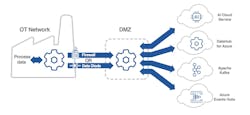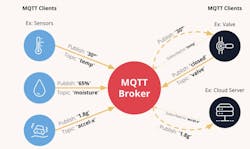Maintaining legacy automation systems might seem like a routine part of an engineer’s job, but with industry’s growing focus on data analytics to continuously improve operations, long-existing equipment in manufacturing facilities is increasingly seen as a trove of bountiful data. In fact, more and more automation professionals increasingly see legacy automation as being where the real action is for the digital transformation of manufacturing.
“These systems are the beating heart of operations and operations technology (OT),” said Eugene Spiropoulos, global autonomous systems manager at Yokogawa. “The IT/OT convergence that drives digital transformation only scratches the surface without considering the underlying data in existing automation systems that interact directly with field sensors and valves, with control intelligence in systems and subsystems, and with human beings.”
These connections are why legacy equipment is typically a rich source of ready information to support digital transformation.
Even so, integrating these systems into a digital transformation plan can be daunting for a variety of reasons. First and foremost, these systems tend to be old. On top of that, many manufacturing facilities have locked themselves—to one degree or another—into proprietary technology from one vendor. And then there’s the issue of many legacy systems not being able to communicate easily with other systems.
“With disparate systems connecting in many ways and requiring many types of data that may or may not be available, it doesn’t take long to wind up with a complex web of interconnected systems strung together by a very fragile framework,” said Aaron Crews, global director of modernization at Emerson.
What’s more, there are a lot of legacy systems still in service and they’re not going anywhere soon.
“The average timespan between upgrade cycles in a manufacturing system is somewhere between 15 to 20 years,” noted Xavier Mesrobian, vice president of sales and marketing at Skkynet. “The cost of upgrading them in many cases is so significant that you can’t do it one shot.”
Consequently, integrating legacy systems into a digital transformation program requires a long-term strategy that is both cost effective and future facing. “This strategy must consider how the underlying systems technologies can be leveraged, improved, operationally transformed and sustained,” added Spiropoulos.
Security should come first
For Mesrobian, the first and foremost consideration for integrating legacy automation into a digital transformation plan is security. “Legacy systems were never designed to connect in a modern world,” he said. “Because they use a client-server architecture, you have to put controls into that system to prevent an outside offender from gaining entry.”
Establishing those controls begins with isolating the OT network from the outside world by erecting a firewall around the network. “The first rule of security is never to open any inbound firewall ports on the control systems,” Mesrobian stressed. To export data to IT networks, he recommends adopting a publish-subscribe communications strategy that avoids direct connections to the outside by having OT devices send data to a proxy in a demilitarized zone (DMZ).
A common problem with legacy systems is that their communications protocols typically do not bring data across firewalls. “So, you need to transform that data so that it can be part of a digital transformation strategy,” said Mesrobian.
Among the ways to do this is to organize data from the legacy system into message-queuing telemetry transport (MQTT) packets and then publish them to a proxy in the DMZ. Another publish-subscribe option is Kafka, which is considered by some to be more scalable than MQTT and is popular for cloud services. In the case of Skkynet’s Cogent DataHub, the software uses the DHTP protocol to establish outbound connections from the OT network to the DMZ. In the DMZ, the Cogent DataHub establishes one-way or bidirectional connections to an IT network or cloud service using MQTT, DHTP, Kafka or Event Stream.
The strategy of isolation is not just for securing legacy automation against IT networks and the cloud. A version of the isolation strategy also applies to each segment of the network itself. “IEC 95 standards recommend dividing the network into segments and using DMZs to isolate each,” explained Mesrobian. Each of these segments should have its own firewall.
Then, of course, you need to know who or what is connecting to the network—when why and how. “You need to control every aspect of the connection, from permissions to usernames to passwords,” advised Mesrobian. “You want to use time-based, one-time passwords for two-factor authentication of any remote communications.”
Artificial intelligence (AI) is helping here. “Some of the large security companies are using it to control their firewalls,” said Mesrobian. “For instance, they use it to inspect packets to identify people or devices that have access to data on the network.”
I/O to the rescue
In the process industries, reaping some of the most desirable benefits from digital transformation often requires modernizing the distributed control system (DCS) layer. “Sometimes, that is the only way to control the process better and get specific, necessary types of data out to other systems,” explained Crews.
However, because the DCS is wired to the process, digitalization can often be a slow and tedious task.
Some emerging technologies can be used streamline this modernization. One such technology is what Crews calls I/O-agnostic interfaces. “With these interfaces,” he said, “users can leave the existing I/O from one control system in place, remove the controller and use the interface to connect a new control system from a different manufacturer to existing infrastructure.” This gives you the desired advanced capabilities and instrumentation as well as the means to capture the necessary context—all without having to rip and replace everything.
“It lets digital transformation teams reallocate up to 40% of the capital for the project—what they would have otherwise spent on transitioning I/O,” added Crews. Teams can spend those resources to accelerate their digital transformation plans by modernizing more systems or adding other technologies to collect and analyze more layers of data that might be needed to optimize processes.
Innovations in I/O can also help with integrating legacy machinery into digital transformation projects. Machine-mountable I/O is an example offered by Brandon Stiffler, automation software product manager at Beckhoff Automation. It can benefit legacy machinery when electrical cabinets lack space to house the additional devices necessary for digital transformation. In such cases, a high premium on floor space often makes it difficult to justify the expense of adding another cabinet.
Examples of machine-mountable I/O and industrial controllers include Beckhoff’s EtherCAT Box I/O series and its C7015 industrial PC. These devices connect to legacy equipment and the upstream central controller. “Pluggable terminals installed on PCBs, such as our EJ series I/O, can also help create a drop-in edge solution with ample signal flexibility for these types of digital transformation initiatives,” said Stiffler.
AI streamlines integration
Further benefits can accrue with the use of another set of emerging technologies, namely cloud-native tools that exploit AI. “These tools deliver fully integrated digital workflows that automatically transform legacy control logic into fully tested and documented modern logic for a new control system,” said Crews.
“The artificial intelligence identifies what’s happening inside the systems and standardizes it, simplifying the task of data contextualization at the enterprise level,” he explained. “Along the way, this shortens the process of converting control logic, again contributing to a faster return on investment.”
It also makes the entire task digital, eliminating a source of human error.
“We’ve seen the advantages of integrating cloud computing and machine learning in new applications,” added Stiffler. “But before you can get to that level, you still must address the less exciting aspects of accessing and using data. On top of that, gaining access to the original code and knowing how it works may inhibit some of the impressive capabilities we see in today’s breakthrough tech.”
Stiffler noted that Beckhoff has been showing a preview of TwinCAT Chat technology that uses AI and large language models to generate code, debug it and add comments. “If engineers can access old code that falls in the IEC 61131 standard, they can use AI tools like this to add comments or essentially reverse engineer it,” he said. “That enables them to optimize the program based on data-driven insights or simply eliminate bugs that might have been causing issues for years.”
Migrate toward openness
Establishing connectivity to older machinery often requires a significant amount of work to get around the inflexibilities of legacy systems. “For example, the communications protocol you need [for digital transformation applications] will likely not be native to the existing controller or SCADA system,” said Stiffler.
One way around such obstacles is to migrate toward open communications. “Whether you’re feeding data to an industrial PC, local server or an IoT coupler connected to the cloud, you’ll want to ensure that the device supports protocols like MQTT for easy, standardized communication,” he suggested. “Having a unified namespace and publish-subscribe capabilities simplifies information sharing at the enterprise—or even the cloud—level.”
Another way around obstacles to connectivity exists at the fieldbus level. Here, Stiffler pointed to EtherCAT-based industrial Ethernet because it can streamline connectivity to machines of all types, regardless of age. “Beckhoff offers gateways to nearly any industrial protocol as standard components of our EtherCAT I/O portfolio,” he said. “This means you can combine newer equipment on EtherCAT, Profinet or EtherNet/IP with legacy equipment that talks serial, CANopen and so forth.”
Whichever technology is used, digital transformation should bring with it simplification and standardization of the information architecture and connectivity pathways. Hand in hand with that should be unification of data. “Bringing automation and information siloes together to unify operations and maintenance is a huge opportunity with today's technologies,” explains Karthik Gopalakrishnan, digital transformation consultant at Yokogawa.
Another key consideration for connectivity is contextualization. “Taking advantage of information contextualization and standardization models, using technologies like OPC UA, allows for the consistent modeling of information from legacy systems and other applications into re-usable building blocks of data that can interoperate across the enterprise,” said Gopalakrishnan. “There is a tendency to continue to work with flat time series data streams that do not take advantage of consistent information models. Not doing this can cause major problems down the line.”
Some of these problems stem from each application creating its own unique information context to add operational value separately from other similar applications. Not only does the practice require higher bandwidth to transmit the information, but it also may lead to re-engineering to facilitate the sharing of that information.
To prepare for the future, Gopalakrishnan suggests taking part in the worldwide interoperability movement called the Open Process Automation Forum. “It aims to implement control systems as software defined, interoperable workloads that seamlessly integrate both legacy systems and future-facing technologies like artificial intelligence, IIoT, edge computing and the cloud,” he said.
Leaders relevant to this article:




